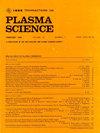Erosion–Corrosion of Metal Electrodes in Liquid-Phase Spark Plasma With Phenol Solution Medium
IF 1.5
4区 物理与天体物理
Q3 PHYSICS, FLUIDS & PLASMAS
引用次数: 0
Abstract
Liquid-phase discharge plasma is a promising technology for environmental applications, but the erosion and corrosion of metal electrodes remain a critical challenge that limits its long-term efficiency and stability. This study investigates the erosion–corrosion behavior of seven metal electrodes (Fe, Al, Cu, W, Ti, Ni, and Mo) in a phenol solution under pulsed discharge plasma. The effects of discharge power, peak voltage, solution pH, and conductivity on electrode erosion–corrosion were investigated. Surface morphology and composition of the electrodes were analyzed using scanning electron microscopy (SEM), energy-dispersive X-ray spectroscopy (EDS), and X-ray photoelectron spectroscopy (XPS). The results revealed that higher discharge power and peak voltage significantly increased erosion–corrosion, with Al exhibiting the highest material loss and Fe and Ti showing the least. Solution pH had minimal impact, while higher conductivity reduced erosion–corrosion due to suppressed plasma generation. Post-discharge analysis indicated the formation of distinct surface features, including smooth-edged pits on Fe, Al, and Mo electrodes and flat pits on Cu, W, and Ti electrodes. Metal oxides formed on the electrode surfaces, with Ti developing the thickest oxide layer. Residual metal ions (Fe2+, Fe3+, Al3+, Cu2+,金属电极在液相火花等离子体中苯酚溶液介质的腐蚀
液相放电等离子体是一种很有前途的环境应用技术,但金属电极的侵蚀和腐蚀仍然是限制其长期效率和稳定性的关键挑战。本研究研究了七种金属电极(Fe, Al, Cu, W, Ti, Ni和Mo)在脉冲放电等离子体苯酚溶液中的腐蚀行为。研究了放电功率、峰值电压、溶液pH和电导率对电极侵蚀腐蚀的影响。采用扫描电镜(SEM)、x射线能谱(EDS)和x射线光电子能谱(XPS)对电极的表面形貌和组成进行了分析。结果表明,放电功率和峰值电压越高,侵蚀腐蚀越严重,Al的材料损失最大,Fe和Ti的材料损失最小。溶液pH值的影响很小,而更高的电导率可以抑制等离子体的产生,从而减少侵蚀腐蚀。放电后分析表明,形成了明显的表面特征,包括Fe、Al和Mo电极上的边缘光滑的凹坑,以及Cu、W和Ti电极上的扁平凹坑。在电极表面形成金属氧化物,其中钛形成最厚的氧化层。在溶液中检测到残余金属离子(Fe2+, Fe3+, Al3+, Cu2+, $\text{WO}_{4}^{2-}$, Ti2+和Ni2+)和纳米颗粒(80-300 nm),随着时间的推移,Fe3+, Al3+, Cu2+和Ni2+形成氢氧化物沉淀。该研究为金属电极在放电等离子体作用下的侵蚀腐蚀机制提供了重要见解,为等离子体废水处理系统中电极材料的选择和优化提供了基础。
本文章由计算机程序翻译,如有差异,请以英文原文为准。
求助全文
约1分钟内获得全文
求助全文
来源期刊

IEEE Transactions on Plasma Science
物理-物理:流体与等离子体
CiteScore
3.00
自引率
20.00%
发文量
538
审稿时长
3.8 months
期刊介绍:
The scope covers all aspects of the theory and application of plasma science. It includes the following areas: magnetohydrodynamics; thermionics and plasma diodes; basic plasma phenomena; gaseous electronics; microwave/plasma interaction; electron, ion, and plasma sources; space plasmas; intense electron and ion beams; laser-plasma interactions; plasma diagnostics; plasma chemistry and processing; solid-state plasmas; plasma heating; plasma for controlled fusion research; high energy density plasmas; industrial/commercial applications of plasma physics; plasma waves and instabilities; and high power microwave and submillimeter wave generation.
 求助内容:
求助内容: 应助结果提醒方式:
应助结果提醒方式:


